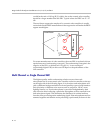
Designing Audio Conferencing Systems
B - 27
intelligibility. If they do, then the system is set correctly. The reinforced levels
should never exceed conversational speech levels (approximately 70 dBA SPL
typical at the listener's ear) or the result may become unstable, creating
residual echoes to the remote listeners due to low ERL and worse may
generate very loud acoustic feedback in the room with loudspeaker audio
coupling into the local microphones.
Voice lift is typically needed when the room is large enough that the local
talkers' audio drops below 60 dBA SPL when heard by the farthest listener in
the room. Based on normal speech conversation levels of 70 - 77 dBA SPL this
roughly corresponds to listeners that are approximately 20 to 25 feet away
from the talker. Another way to view this is as a critical distance issue. If the
local listeners are farther away than the critical distance form the local talker,
some form of voice lift may be required for adequate intelligibility.
For rooms smaller than approximately 20 feet x 20 feet, the voice lift
application is really not necessary and is just starting to be of some benefit in
rooms 30-feet (9 meters) square. Just as adding gain to a microphone to try to
compensate for a critical distance issue does not work, adding sound
reinforcement to compensate for a noisy room doesn't work well either. The
microphones that pick up the noise will reinforce that noise into the room,
adding to the noise rather than making it easier to be heard. The correct
approach would be to get rid of the noise and make the room useful in all
applications.
So, how does one realistically go about making this system work? One must
be careful planning microphone and speaker locations, so that the system stays
acoustically stable (that is, no squealing and howling of feedback as different
microphones come active) while providing the necessary pickup of local
talkers and reducing the "effective acoustic distance" (how far away do they
sound) of the listeners. First, consider the number of "zones" or areas of
independent loudspeaker playback. A "zone" is most often sized close to the
largest room size that does not need reinforcement, or about 20-feet square. A
room 20-feet by 40-feet would be 2 zones, one 40-foot square would be 4 zones
and so on. Long, narrow boardrooms will often require this type of voice
reinforcement application.
Once the “zones” are planned, the microphone locations are selected within
those zones. The concept here is to locate microphones and speakers such that
each zone is completely independent in level and mix. This way, microphones
from a given zone are never played into the loudspeakers associated with that
same zone (mix-minus) and are sent at increased levels to zones further away
(the inverse square law calculated results drives the required level settings in


















